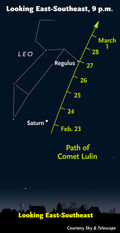24 Feb Looking for Comet Lulin
Feb. 24, 2009
Comet Lulin
 There's a weird, double-tailed comet in the night sky this week and it can be spotted with a pair of good binoculars, even through low-level light pollution. And in the beautifully clear, high-altitude atmosphere of the San Juan Mountains, even naked eye viewing is possible. But, you'll have to know exactly where to look. The chart at right should get you there – it shows the starry scene about 9 p.m. – but the viewing will actually get better later, after 10p.m., when the comet and its background rise higher.
There's a weird, double-tailed comet in the night sky this week and it can be spotted with a pair of good binoculars, even through low-level light pollution. And in the beautifully clear, high-altitude atmosphere of the San Juan Mountains, even naked eye viewing is possible. But, you'll have to know exactly where to look. The chart at right should get you there – it shows the starry scene about 9 p.m. – but the viewing will actually get better later, after 10p.m., when the comet and its background rise higher.
The comet, formally known as "C/2007 N3 (Lulin)", was discovered at Lulin Observatory in Taiwan in July 2007. In telescopes and low-light images, it's showing both a dim gas tail and a dust-spike antitail pointing in nearly the opposite direction. Its current brightness is about magnitude 5.2.
How to Find It:
To locate the planet Saturn, watch the eastern horizon at twilight and early evening. Eventually, you will see two distinct points of light shining in the east-southeast sky. Regulus, the "heart star" of the Leo the Lion, rises first, followed shortly thereafter by a larger, brighter Saturn. The comet Lulin can be seen traveling close-by and in front of these two celestial objects. Sometime between midnight or 1:00 a.m., this cosmic trio will reach zenith – the highest point of their ascension – in the southern night sky. For those with telescopes, Saturn rings are just 2º from "edge on." Good luck and happy viewing!
 From Sky & Telescope 02.24.09
From Sky & Telescope 02.24.09
"Comet Lulin this week is at its brightest and closest to Earth – right when the night sky is conveniently moonless. Use binoculars or a telescope to look for it once it's well up in the late evening. The comet is glowing at about magnitude 5.6 as it moves rapidly westward across Virgo.
In recent days the comet's dust-spike anti-tail has grown longer and stronger, completely outclassing its "true" tail, which points properly away from the Sun like a comet's tail should. On Monday night, Feb. 23rd, the comet passes 2º south-southwest of Saturn. Lulin's closest approach to Earth, 0.41 a.u. (61 million km), occurs on Feb. 24th. On the night of Feb. 25th the comet goes through opposition, nearly 180º from the Sun in our sky. Will there be an "opposition effect" brightening of its dusty coma and dust tail?"


Sorry, the comment form is closed at this time.